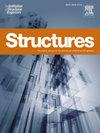Developing novel nuclear containment structures: Current status and future prospects
IF 3.9
2区 工程技术
Q1 ENGINEERING, CIVIL
引用次数: 0
Abstract
Nuclear containment structures serve as the main line of defense to prevent escape of radioactive material during catastrophic events including the loss of coolant accident (LOCA), aircraft impact, explosions and earthquake. For more than half a century, structural types of nuclear containment remain essentially unchanged. With construction cost of recent nuclear projects increasing significantly, there is need to improve containment structures in order to achieve better cost efficiencies, schedule improvement and sustainability by utilizing the latest industry trends, technologies and innovations. Future novel containment may use Steel-Plate Composite (SC), Ultra High Performance Concrete (UHPC), 3D printing Concrete (3DPC), performance-based and risk-informed design method, and so on. With a lack of industry experience, however, specialists in aforementioned technical areas face additional challenges in spreading knowledge to nuclear containment designers so that the latter can be versed in applying those technologies. For these reasons, a comprehensive literature study on recent development trends on novel nuclear containment structures should be conducted. This article provides a comprehensive survey of current technological challenges and prospects for developing various novel containment types. Advantages and shortcomings of each technology, as well as their applicability in nuclear containments are evaluated and discussed. This state-of-the-art review is aimed at helping designers and researchers of future nuclear containments widen the use of relevant technologies and innovations. This review can serve as a starting point for developing future novel containment structures.开发新型核安全壳结构:现状与前景
核安全壳结构是防止放射性物质在冷却剂损失事故(LOCA)、飞机撞击、爆炸和地震等灾难性事件中泄漏的主要防线。半个多世纪以来,核安全壳的结构类型基本保持不变。随着近期核项目建造成本的大幅增加,需要利用最新的行业趋势、技术和创新来改进安全壳结构,以实现更好的成本效益、进度改进和可持续性。未来的新型安全壳可能会使用钢板复合材料(SC)、超高性能混凝土(UHPC)、3D 打印混凝土(3DPC)、基于性能和风险的设计方法等。然而,由于缺乏行业经验,上述技术领域的专家在向核安全壳设计人员传播知识,使后者能够熟练应用这些技术方面面临更多挑战。因此,需要对新型核安全壳结构的最新发展趋势进行全面的文献研究。本文全面介绍了当前各种新型安全壳的技术挑战和发展前景。文章评估并讨论了每种技术的优缺点及其在核安全壳中的适用性。这篇最新综述旨在帮助未来核安全壳的设计者和研究人员扩大相关技术和创新的应用范围。本综述可作为开发未来新型安全壳结构的起点。
本文章由计算机程序翻译,如有差异,请以英文原文为准。
求助全文
约1分钟内获得全文
求助全文
来源期刊

Structures
Engineering-Architecture
CiteScore
5.70
自引率
17.10%
发文量
1187
期刊介绍:
Structures aims to publish internationally-leading research across the full breadth of structural engineering. Papers for Structures are particularly welcome in which high-quality research will benefit from wide readership of academics and practitioners such that not only high citation rates but also tangible industrial-related pathways to impact are achieved.
文献相关原料
| 公司名称 | 产品信息 | 采购帮参考价格 |
|---|
 求助内容:
求助内容: 应助结果提醒方式:
应助结果提醒方式:


